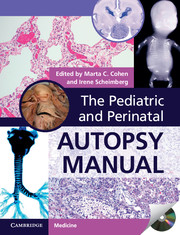Book contents
- Frontmatter
- Contents
- List of contributors
- Foreword
- Preface
- Acknowledgments
- 1 Perinatal autopsy, techniques, and classifications
- 2 Placental examination
- 3 The fetus less than 15 weeks gestation
- 4 Stillbirth and intrauterine growth restriction
- 5 Hydrops fetalis
- 6 Pathology of twinning and higher multiple pregnancy
- 7 Is this a syndrome? Patterns in genetic conditions
- 8 The metabolic disease autopsy
- 9 The abnormal heart
- 10 Central nervous system
- 11 Significant congenital abnormalities of the respiratory, digestive, and renal systems
- 12 Skeletal dysplasias
- 13 Congenital tumors
- 14 Complications of prematurity
- 15 Intrapartum and neonatal death
- 16 Sudden unexpected death in infancy
- 17 Infections and malnutrition
- 18 Role of MRI and radiology in post mortems
- 19 The forensic post mortem
- 20 Appendix tables
- Index
- References
16 - Sudden unexpected death in infancy
Published online by Cambridge University Press: 05 September 2014
- Frontmatter
- Contents
- List of contributors
- Foreword
- Preface
- Acknowledgments
- 1 Perinatal autopsy, techniques, and classifications
- 2 Placental examination
- 3 The fetus less than 15 weeks gestation
- 4 Stillbirth and intrauterine growth restriction
- 5 Hydrops fetalis
- 6 Pathology of twinning and higher multiple pregnancy
- 7 Is this a syndrome? Patterns in genetic conditions
- 8 The metabolic disease autopsy
- 9 The abnormal heart
- 10 Central nervous system
- 11 Significant congenital abnormalities of the respiratory, digestive, and renal systems
- 12 Skeletal dysplasias
- 13 Congenital tumors
- 14 Complications of prematurity
- 15 Intrapartum and neonatal death
- 16 Sudden unexpected death in infancy
- 17 Infections and malnutrition
- 18 Role of MRI and radiology in post mortems
- 19 The forensic post mortem
- 20 Appendix tables
- Index
- References
Summary
Definition
There have been many definitions to describe the sudden and unexpected death of an infant or child. Most exclude deaths in the first week and after the first year.
Most people use the term sudden unexpected death in infancy (SUDI) to mean a death that was not anticipated as a significant possibility 24 hours before the death. It would include deaths occurring as a result of an acute illness not anticipated 24 hours before the death, deaths arising from a previously known condition not expected to lead to death, or deaths arising from a pre-existing condition not previously recognized. It usually includes those deaths resulting from accident, trauma, or poisoning.
The cases where the cause of death is not known after a full and detailed history, death scene investigation, full pathology using a standardized protocol, and multi-agency review are then described as sudden infant death syndrome (SIDS). Of course, if a cause is found then the death does not belong to the category of SIDS.
The diagnosis of SIDS should not be used unless there is a full post mortem with no positive findings.
The term cot death was used in the past. This is no longer a useful term as the majority of infants are not found in the cot and some parents believe that if the child is not in its cot it will not be a cot death.
- Type
- Chapter
- Information
- The Pediatric and Perinatal Autopsy Manual , pp. 319 - 329Publisher: Cambridge University PressPrint publication year: 2000
References
- 2
- Cited by



